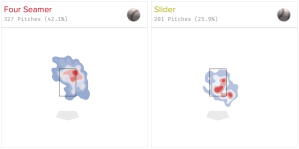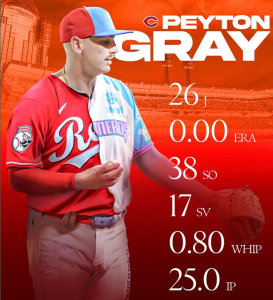Tyler Matzek has had a dominant run in the Atlanta Braves‘ bullpen since he re-entered the affiliate ranks in 2019. Following a bout with the Don’t Say It ‘Yips,’ he ventured into the independent leagues, re-emerging as a back-end bullpen mainstay. While there have been many such cases of players dipping their toes into the independent leagues and returning to the major leagues such as Scott Kazmir and Rich Hill, it’s even more unusual to play ‘Indy Ball’ and make it to the ‘Big Leagues’ without prior experience at the game’s highest level. These low odds don’t deter everybody, however, and for two minor league journeymen, their dreams live on. Tanner Kiest (29 years old) and Peyton Grey (28 years old) both recently inked contracts with the Giants and Reds, respectively, after stints in Indy Ball. Kiest signed last summer and Grey signed this winter. Both players have unique stories and pitch shapes and are intriguing and exciting prospects to follow despite their prior experience (each player is now with their third MLB organization) and advancing ages.
Tanner Kiest
Kiest is a flame-throwing reliever who originally signed with the Phillies in 2014. He had a stint in the USPBL independent league before signing with the Twins and, following his release, went on to play for five more independent league teams before signing with the Giants. His journey also involved a stint last winter in Mexico and a brief retirement from pitching after the 2020 season. He has thrown in the upper 90s for years but has also battled command issues at times. Since signing last summer, however, he put up a 12 K/9 in High-A and a 17.7 K/9 in an 8.2-inning stint in the renowned Dominican Winter League.
Giants signed RHP Tanner Kiest (28.8Y, 6'3" 200) to a minor league contract. 2014 28R pick by PHI out of Chaffey College. Released in 2015. Signed with MIN in 2018, released 7/2018. 2018-23 in indy ball.
2023 (Frontier): 6IP 11K/2BB.
FB 95-97, mid 80s SL. pic.twitter.com/ZMs8GytwWj— GPT (@giantsprospects) June 2, 2023
Kiest’s arsenal on the mound includes the aforementioned heater, touching 99, with both ride and run. While he has thrown both four- and two-seam fastballs, he has been throwing two seams more recently which have a good bit of lift (~10″ IVB) but also impressive arm-side movement (16+” HB). His high extension (7+’) and low release height around 5′ lead to a combination of many positive attributes on the fastball that averages over 95 mph. His primary off-speed pitch is a gyro leaning slider that has both glove-side movement and depth, exhibiting slightly more topspin and spin efficiency than a classic gyro. It has about 4″ of movement in each direction and averages 86 mph. The velocity is enough to make it an above-average MLB pitch if executed properly down in the zone. His extension continues to play to his advantage on the slider too as the velocity will play higher than the radar gun reading. He doesn’t throw his slider in the zone quite as much as his fastball, but throwing it down out of the zone sets it up well to have a higher chase rate.

Kiest celebrates his signing from the Joliet Slammers to the San Francisco Giants.
Kiest’s extension and arsenal resembles that of the recently retired Trevor May with slightly more velocity. Both boast a 7′ extension towards home plate with a four-seam and gyro slider combination. May (as seen in the graphic below) got swings and misses from throwing the fastball up in the zone and slider down and to his glove side. The graphic is from the hitter’s view and shows that many of the slider swings and misses come on pitches thrown out of the zone. For reference, May averaged 1 mph slower on his similarly shaped slider than Kiest and had a peak fastball velocity (97-98) 1 mph below Kiest’s. Even at the height of May’s career (2018-2020), his slider was slower than Kiest’s and his fastball was the same velocity (95 mph average). While Kiest is starting to throw more two seams, his ‘Stuff’ clearly has MLB potential as, in a vacuum, it eclipses that of a formerly elite MLB reliever.

Trevor May’s average locations on fastball and slider from 2023 (Baseball Savant).
While the Giants sent him to High-A Eugene, he’s quickly approaching 30 years old and could be a quick riser in their system. The Giants don’t need to send him straight to Triple-A to start the approaching season, as quick success in Double-A Richmond in the early going of 2024 should lead him to Sacramento soon enough anyway. His success in spring training and in MLB games as a backup will be a great test to determine his placement to start the season. A good comparison for him would be Bubby Rossman who signed with the Phillies following a similar circuitous route back to affiliate baseball, leading to his debut in 2022. Kiest’s 17 strikeouts in 8.2 innings in the Dominican with just two walks is a great sign for things to come for him in 2024.
El cero de Tanner Kiest con bases llenas – ufff pic.twitter.com/X6TBbgQm4S
— Toros Del Este (@TorosdelEste) October 25, 2023
Peyton Gray
Congratulations to Peyton Gray! 🐮🎉
After 3 seasons with the Milkmen, Gray has signed with the @Reds 🔴 Best of luck with your new team Peyton!#GoMoo pic.twitter.com/SgehlysnMs
— Milwaukee Milkmen (@MKEMilkmen) December 18, 2023
Peyton Gray isn’t quite the fireballer that Kiest is but he makes up for his comparative lack of velocity with elite movement. Gray is on his third organization too (Rockies/Royals), but he has struck hitters out at every stop in his journey. He has never had a K/9 below 9.0 in affiliate baseball and his career minor league total is 14.5 in 69 innings pitched. He dipped down to as low as the mid-80s in velocity with the Rockies before his release, dominated in Indy Ball in 2020, and returned to the affiliate ranks with the Royals in 2021. He showed improved velocity with the Royals as he averaged 90 mph, with nearly 19″ of IVB.
Also showcasing good release qualities of extension just below 7′ and a release height around 5’6″, Gray’s fastball profile is more impressive than the velocity indicates. Even with the improved velocity, however, Gray still found himself released at the 2021 season’s end after scuffling slightly in Double-A with an ERA of 6.14 despite a 33% strikeout rate. He went back to the independent circuit’s American Association in 2022 and 2023, posting a healthy season this past year with elite numbers: A 1.38 ERA, a 14.8 K/9, and a 1.8 BB/9. Even after his 2023 season and increased velocity ticking up to the low-mid 90s at its peak, he had to continue dominating to earn a contract with the Cincinnati Reds. He ventured down to Mexico for the second straight winter this year and joined the pitching staff of the Algodoneros de Guasave in the Mexican Winter League. He completed a staggering stint of 25 innings without allowing an earned run before signing with Cincinnati. That sample included an immaculate inning, 38 strikeouts, 10 walks, and 17 saves in a talented and high-leverage environment. While it remains to be seen if Mexico’s foreign substance checks are as thorough MLB umpire checks, Gray has undeniably earned his next shot.
Para la historia 🤩🏅
Peyton Gray con un inning inmaculado 😎
9 lanzamientos 🔥
9 strikes 🙌
3 ponches 🍫🍫🍫#LAMPxSKY #SkySportsMX #LigaARCO ⚾ pic.twitter.com/TqnmQ3nhOV— Liga ARCO Mexicana del Pacífico (@Liga_Arco) December 10, 2023
Along with his vert-ball fastball, Gray has the unique off-speed pitch to make a run at the major league level in 2024. His primary off-speed pitch is his splitter which has 10″ less induced vertical break than his four seamer. It also kills about 10 mph off of the fastball and had over a 50% miss rate in 2021 with the Royals. He also added a sweeper in 2021 that has over 10″ of glove-side movement but is only around 80 mph. While a solid third pitch despite the below-average velocity, it likely isn’t hard enough to be a whiff pitch at the big league level and will be serviceable as more of a ‘get me over.’ The sweeper was used as such in 2021 and had well below-average miss rates compared to other breaking balls. With his fastball usage around 70%, likely the biggest hurdle for Gray is developing confidence in his off-speed pitches and increasing their usage. While other pitchers have had wild success with unique fastballs despite extremely high usage rates in the minor leagues (Joe Ryan comes to mind here), they usually round out their usage rates a bit at the game’s highest level. As Gray reaches the upper minors in 2024, throwing early count sweepers and more splitters to both righties and lefties will help his fastball continue to find success despite below-average MLB reliever velocity. Clearly, what he has done recently has worked though so perhaps he already has the formula for his own success. The Reds certainly believe that his 2023 season wasn’t an anomaly and that his other organizations made a mistake in releasing him.

Peyton Gray’s dominant numbers from the 2023-2024 winter league season.
Few MLB pitchers have Gray’s low four-seam fastball velocity, particularly as a reliever. While his release height isn’t as low as Paul Sewald’s, he exhibits some of the same tendencies: below-average fastball velocity with elite movement and high usage of the heater. Sewald primarily works with a fastball and sweeper but really relies on his low 90s heater up in the zone similar to Gray. Gray’s actual movement is comparable to that of the Guardians Eli Morgan who averages around 92 mph with 18+” of vertical break and a split change up as his primary off speed. Morgan balances his pitch usages a little more evenly than Gray, perhaps providing an outline for how Gray should progress moving forward. Morgan has posted two consecutive seasons of sub-4.00 ERA seasons out of the bullpen for Cleveland showing a path to success for Gray.
Regardless of their outcomes, Gray’s and Kiest’s stories are those of resilience. To be released by two organizations between stints in independent leagues, face the contraction of the minor leagues, endure trips overseas to play to get a paycheck, and overcome (likely) many mental battles are not small feats and should be applauded. These two players won’t just be getting participation trophies though and have legitimate shots to crack the Major Leagues in 2024. Both have put up incredible numbers in elite winter leagues in the past few months and dominated in 2023; Both pitchers have unique fastballs and intriguing off-speed pitches and have experience in pressured situations. Kiest is likely closer to the big leagues due to a better secondary pitch and more horsepower in his engine but Gray has had more consistency in his results and has already played in Double-A. Also, the playoff-hopeful Reds wouldn’t have signed Gray without the thought that he could make an impact. Each pitcher will surely be a backup in MLB spring training games which will be far more revealing than any analysis could be. Early spring success could lead to each arm breaking camp in Triple-A and being just one call away when the season begins.
